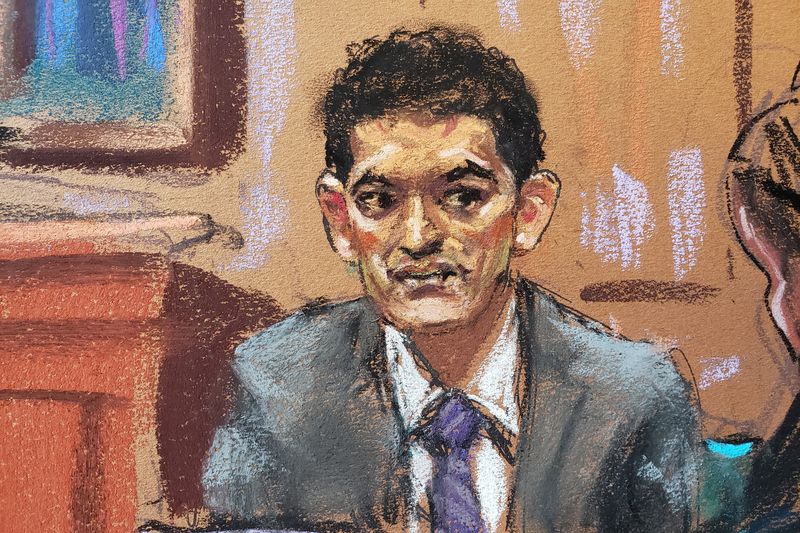By Luc Cohen and Jody Godoy
NEW YORK (Reuters) - FTX founder Sam Bankman-Fried testified on Monday that he believed his Alameda Research hedge fund had enough assets to cover an $8 billion debt to the cryptocurrency exchange until days before both collapsed.
Testifying in his own defense at his fraud trial, the 31-year-old former billionaire told jurors that he was concerned and surprised, but not alarmed, upon learning in October 2022 that Alameda had borrowed $8 billion from deposits that FTX customers sent to the exchange.
"If it were far larger, I would have been calling a crisis," Bankman-Fried said from the witness stand in Manhattan federal court in response to questions from his defense lawyer, Mark Cohen.
Prosecutors have said the Massachusetts Institute of Technology graduate looted billions of dollars in FTX customer funds to prop up Alameda, make speculative venture investments and contribute to U.S. political campaigns. If convicted, he could face decades in prison.
Bankman-Fried has pleaded not guilty to two counts of fraud and five counts of conspiracy. He has acknowledged making mistakes that led to FTX's Nov. 11, 2022, bankruptcy, harming customers and employees. But he said he did not steal customers' money.
On the witness stand in federal court in Manhattan, Bankman-Fried has sought to offer alternative explanations for what happened to the money. He has sought to emphasize that FTX was a "margin" exchange, where many customers, including Alameda borrowed money from other users to place bets.
On cross-examination, prosecutor Danielle Sassoon asked Bankman-Fried about testimony earlier this month in which Caroline Ellison, Alameda's former chief executive officer and Bankman-Fried's on-and-off girlfriend, said the fund in June 2022 borrowed money from FTX customers to repay its lenders.
Sassoon asked Bankman-Fried several times whether taking FTX funds to repay lenders was margin trading.
"It's my testimony that it depends on the details but that it very well could be a margin trade," Bankman-Fried said, sighing. "I'm not saying that's what happened, and I'm not saying that's not margin trading."
BANKMAN-FRIED SAYS HE 'TRUSTED' DEPUTIES
Bankman-Fried said some of Alameda's debt to the exchange was the result of FTX customers depositing their money into an Alameda bank accounts - which was necessary because the exchange did not have its own bank accounts.
Sassoon asked Bankman-Fried if he could identify FTX customers besides Alameda who received deposits on behalf of other customers.
"Not with 100% confidence," Bankman-Fried said, while rocking slightly side to side.
In his testimony, Bankman-Fried has portrayed himself as a hands-off CEO who frequently left operational details to others, part of an effort to discredit testimony from his former confidantes that he directed them to commit crimes.
For example, FTX computer programmers Nishad Singh and Gary Wang - who have pleaded guilty and agreed to cooperate with prosecutors - testified that Bankman-Fried directed them to grant Alameda special trading privileges on FTX that prosecutors say allowed the fund to siphon off customer funds.
Bankman-Fried testified on Friday that said he asked Wang and Singh to prevent Alameda from getting liquidated by mistake, but did not know their solution was to let Alameda run a negative balance.
On Monday, prosecutor Sassoon challenged that assertion.

"You did not learn the details for the code change that you directed?" Sassoon asked.
"That's correct," Bankman-Fried said. "I trusted Gary and Nishad."
